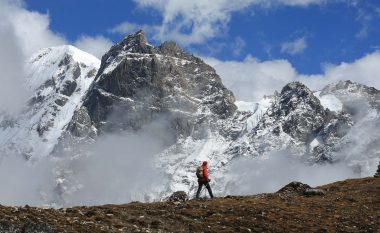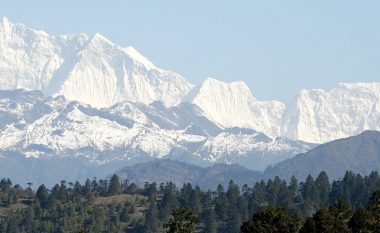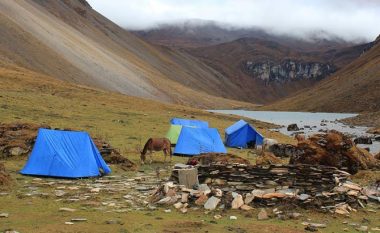- Overview
- Trip Outline
- Trip Includes
- Trip Excludes
- Gallery
- Booking
- FAQ
Day 1: Arrive Paro
The flight into Paro on our national carrier, Druk Air, is a befitting introduction to the spectacular beauty of our country. In clear weather, magnificent views of the world’s highest peaks, give way to the lush green Paro valley as you land. On arrival at Paro international airport, you will be received by our representative and will escort you to hotel. In the afternoon visit is Ta Dzong, an ancient watchtower, which now houses the National Museum. Below the museum is the Paro Rimpung Dzong, the centre of civil and religious authority in this valley. A short walk takes you to the base of the dzong and across a traditional cantilevered, covered bridge. A short distance further is one of the innumerable archery grounds. (Archery is the national sport of Bhutan). If we are lucky, we may catch a match in action.
Day 02: Hike to Taktsang (Tiger’s Nest)
Right after the breakfast drive towards the road point to Taktshang. Taktshang Monastery, the most famous of Bhutan’s monasteries. Taktshang means “Tiger’s Nest,” so named because Guru Rimpoche reportedly flew to the site of the monastery on the back of a flying tiger in the late centuries of the first millennium. The monastery is perched on a cliff nearly 3,000 ft above the Paro valley floor. This day hike is not only historically and culturally interesting, but also incredibly scenic! It takes about two hours to reach the cafeteria, which gives a breathtaking view of the Tiger’s Nest. If you still feel like hiking then you can take another hour to reach the temple. Then return back to hotel and free evening.
Day 03: Drukgyel Dzong, Paro – Shana
(Trek begins)
Altitude: 2,500m/2820m
(Total Altitude Gain: 320m),
Duration 5 hours, Distance 15 Km. Level of Difficulty: Easy.
Starting form Drukgyel Dzong, the fortress that once guarded Paro Valley against Tibetan inviders, the first day is a pleasant walk following the left side of the Pachu River. The farm road serves as the trek route and passes through a number of very small villages with traditional houses, rice and vegetable fields to left and right of the trail. After about an hour’s walk, the farm road ends at Mitsizamp. Crossing a bridge to the right side of the river, the trail climbs very gradually for another hour through the trees to Zakhapang (2,600m), where nice lunch break-spot in an open and clean space is found. After lunch the trek continues through blue pine forests, following the river closely. Gunyitsawa army outpost appears not long before the end of the first day’s trek. The campsite at Shana, just beyond, is situated at an altitude of 2,820m in a beautiful open space surrounded by blue pine forest. Two traditional houses on the other side of the wide, fast-flowing river make up Shana village.
Day 04: Shana – Soi Thangthangka
Altitude: 2,820m/3,580m (Total Alitude Gain: 760m),
Duration 8 hours, Distance 16 Km.
Level of Difficulty: Long but not difficult, Muddy and bumpy path.
This is the longest trekking day, taking eight hours to reach the campsite. The trail continues to follow the river gradually ascending through a mixed forest of blue pine and oak and, later in the afternoon, tall rhododendron trees, birch, fir and maple. Though the trail is rocky and bumpy path, it is not strenuous but in rainy conditions it can be quite muddy. There are several simple wooden bridges to cross and sometimes the river reaches right up to the trail. The lunch break comes after about 4 hours of walking through an ever-narrowing valley: Shing Karap or Thombuzam are popular stopping places at around 3,305m. Several trails leads in other directions, such as the trail to Tremo la, which was the old salt-trading route to Tibet. Not long before reaching the campsite the trail leads you up a ridge with a chorten. Beyond, in the distance, at the end of the valley the Jumolhari Mountain comes into view. Finally, after an 8 hours walk, you reach the campsite. The camp site is located in spacious clearing and directly faces Mount Jumolhari. The view of early morning sun striking the tip of Jumolhari is breathtaking. Mount Jumolhari, at 7326, is among the world’s highest mountains.
Day 05: Soi-Thangthangka – Jangothang
Altitude: 3,580m/4000m (Total Altitude Gain: 420m),
Duration 4 hours, Distance 11 Km.
Level of Difficulty: Short and easy.
The third day’s trek is a short one so it is possible to set off a little later and progress at a leisurely pace. When you reach the army outpost you are required to stop and register your entry permits issued by the army headquarters in Thimphu. This matter will be taken care of by your guide. The Pachu River is again to the right and the trail passes through some very small villages. It will take less then four hours to reach Jangothang, Base Camp. The altitude at the base camp is 4,000m and is a beautiful place to spend the night. The imposing, rounded bulk of the Jumolhari Mountain fills the view to the Northeast and in the evening the profile of the ruined Jangothang Dzong, populated by huge ravens creates a mystical atmosphere. The area is rich in bird life. Birds sighted en route include the Fire-tailed Sunbird, Ibisbill, White throated Dipper, Yellow-billed Chough, Rosy Pipit, Snow Pigeon, Blue-fronted Redstart, Plumbeous Water Redstart, Blood Pheasant, Snow Partridge and many more.
Day 06: Jangothang (Halt)
Today is a day to rest and acclimatize to the altitude. The body also needs times to adjust to the falling temperatures, especially during the night. There is an opportunity to explore the valley and enjoy wonderful views of the mountains. A 2 hour’s leisurely hike will take you to the twin lakes of Tshophu. For those taking the Lingshi variation of the trek, this day trek hike is important. You can also enjoy the view of Cone-shape Jichu Drakey cannot fail to remind the clear blue sky. Jichu Drakey cannot fail to remind you of the Matterhorn from this perspective. It is a sight to hold! Many rank this as the most beautiful mountain in Bhutan.
Day 07: Jangothang – Lingshi
Altitude: 4000m/3915m (Total Altitude loss: 85m),
Duration 5 hours, Distance 12 Km.
Level of Difficulty: Strenuous.
As you climb steeply above the base camp and into an area of glacial moraine, the views of Jichu Drakey and Jomolhari change along with your perspective. As steep and steady climb, sometimes through snow, brings you to the Nylie-La pass at 4890m. From the top of the windy pass enjoy the 380 degree view. Tshering Gang (6,789) also comes into full view. A fairly tough trek over scree or snow leads down to the valley and then follows the side of a ridge towards the impressively situated Lingshi Dzong (4,370m). The camp site is some distance below the Dzong on a flat area near a community building made of stones, at an altitude of 4000m.
Day 08: Lingshi – Chebisa
Altitude: 13,090ft/3990m (Total Altitude gain/loss: No major elevation gain or loss).
Duration 3-4 hours, Distance 10 miles/ 16 Km.
Walk past the Lingshi Dzong, perched on the hilltop with a commanding view of the green hills, the Winding River and magnificent peaks. This is a very easy and pleasant walk, through villages and yak herders’ camps. Lunch will be served at scenic Goyuna village. After lunch, a short walk to Chebisa village and then camp by the side of a stream at an altitude of 13,090ft/3990 meters.
Day 09: Chebisa – Somuthang
Altitude: 13,120ft/4100m (Total Altitude gain/loss: gain 550m)
Duration 7 hours, Distance 9 miles/14.5 Km.
Today begins with a stiff climb up a ridge to Gobu la pass at an altitude of 14,560ft/4440 meters, taking nearly 4 hours to the top. After the pass descend to a lunch spot, through rhododendron bushes. Afternoon continues along an undulating path, after crossing the stream, through rhododendron forests and across yak herder’s camps. You may see some flocks of Blue Sheep now and then. The Shakapasong valley is one of the most beautiful ones on the trek. Arrive at camp.
Day 10: Somuthang – Robluthang
Altitude: 13,645ft/4160m (Total Altitude gain/loss: 685m + 60 at the end ).
Duration 7 to 8 hours, Distance 16 Km.
The trek starts with a climb to Jari la pass at an altitude of 4,600 meters. Then descend to Tsharijathang valley, the summer residence of the rare Himalayan Takin (national animal of Bhutan). From here we may have to cross the stream and get wet, as most of the time the footbridge is washed away. After crossing the stream towards the left the trail ascends to Robluthang camp at an altitude of 13,120ft/4000 meters.
Day 11: Robluthang – Lemithang
Altitude: 13,645ft/4160m (Total Altitude gain/loss: 170m ).
Duration 7 to 8 hours, Distance 10miles/16 Km.
A long climb up to the Shiche la passes (altitude:16,400ft/5000 meters). The views of the mountains from the pass are breathtaking. After the pass descend to Lemithang. The path is quite narrow and you may have to cross the stream and get wet again. The last part of the trek is very interesting, with the view of Mount Gangchey -Ta peak. Arrive at camp with an altitude of 4160 meters.
Day 12: Lemithang – Laya, 10 KM.
walking time 4 – 5 hours Altitude: 12,465ft/3800m.
Duration 7 to 8 hours, Distance 10miles/16 Km.
In the morning you wake up with a superb view of Gangchey Ta peak in front of you. The walk to Laya is very pleasant with wonderful views. You will pass through a damp forest, filled with moss and singing birds. Arrive at Laya village, the second highest settlement in the country, at an altitude of 3,800 meter. The administrative name for the area is Laya gewog and the main villages are Toko, Pashi, Neilo, Lubcha, Tonfra and Lungo. Laya is also part of the Jigme Dorji National park.
Day 13: Rest day at Laya Altitude: 12,465ft/3800m
Explore the village. You can go and visit many of the houses in the village. By tradition one can go to any house without an Invitation. A cup of tea or chang (local drink) is always offered. The people in this village are very interesting with a unique dress, language and ornaments. Overnight Camp.
Day 14: Laya – Koina Altitude: 10,627ft/3240m.
Duration 6 hours, Distance 10 miles/16 Km.
Descend to army camp and join the Mo Chu and follow the river until you cross the bridge. After the bridge it’s up and down several times through juniper and fir forests until you reach the camp at Koina at an altitude of 3,240 meters. The campsite at Koina is muddy, with no proper space to put up tents. However there is hut, which is clean and well looked after by a caretaker. There are also two good toilets in a separate solid-looking building. Bears and Takins (National Animal) have been seen here.There is another camping place call Chamsa, 2 hours further from Koina, but you have to start very early to get there from Laya.
Day 15: Koina – Gasa Tshachu
Altitude: 10,627ft/3240m. Duration 6 hours,
Distance 10 miles/16 Km.
Walk for half an hour over flat land to the Bele la pass(Alt.12,792ft/3900m) It is downhill all the way to Gasa Tsachu (hot spring). Make a stop for Lunch at Gasa village at the altitude of 9053ft/2,760 meters. After lunch visit the village and Dzong. The Dzong was built in 17th century by the first religious king, Shabdrung Ngawang Namgyal, to protect the valley against Tibetan invaders. Then descend to Gasa Tshachu (hot spring) for camp at an altitude of 2,200 meters.
Day 16: Gasa Tshachu rest day
After a long trek this is the place to relax. Enjoy a hot spring bath and explore the surrounding area. You may meet a lot of people coming to this Tshachu for treatments.
Day 17: Gasa Tshachu – Punakha
The path continues descending and ascending, through heavily forested areas with lots of wilds orchids. In this area there are leeches so one must be careful especially in the summer. The last days of trekking will continually follow the Mochu down through heavily forested area until you reach Tashithang at an altitude of 1,620 meters. Our coach will be waiting after you cross Damji village and then drive you to Punakha (55km), following the river all the way. Overnight at the hotel in Punakha.
Day 18: Punakha – Thimphu
In the morning visit gorgeous Punakha Dzong the old capital of Bhutan. It was built in 1637. And then drive to Thimphu for about two and half hours with short stop at Dochula Pass at an altitude of 3,100 meters. On a clear day one can have a magnificent view of the eastern Himalayan range of peaks. Overnight stay in Thimphu.
Day 19: Thimphu sightseeing – Paro
In the morning visit the Buddha Point to see world’s largest statue of Sykhamuni, present lord Buddha. The whole Thimphu city is also best viewed from the Buddha Point. Drive back and visit the Memorial Chorten, built in 1974 in memory of the late king of Bhutan; the Indigenous Hospital where traditional medicines are still practiced; vist the School of Arta and Crafts where children learn the 13 age old traditional arts and crafts.And then drive to Paro in the evening. You will be provided a farewell dinner in a restuarant in Paro town. Overnight stay in Paro.
Day 20: Paro – Flight departure
Our guide and driver will drop you at the airport to bid you good bye for your flight departure back home, and Tashi Delek from our team.
No details found.
Itineraries
Day 1
Arrive Paro
Day 2
Paro (Day Hike to Tigers Nest)
Day 3
Drukgyel Dzong, Paro – Shana
Trek StartsDay 4
Shana – Soi Thangthangka
Day 5
Soi-Thangthangka – Jangothang
Day 6
Jangothang (Halt)
Day 7
Jangothang – Lingshi
Day 8
Lingshi – Chebisa
Day 9
Chebisa – Somuthang
Day 10
Somuthang – Robluthang
Day 11
Robluthang – Lemithang
Day 12
Lemithang – Laya
Day 13
Rest day at Laya
Day 14
Laya – Koina
Day 15
Koina – Gasa Tshachu
Trek EndsDay 16
Gasa Tshachu rest day
Day 17
Gasa Tshachu – Punakha
Day 18
Punakha – Thimphu
Day 19
Thimphu sightseeing – Paro
Day 20
Departure
✓ A Cook
✓ Camp assistance
✓ Horses
✓ Sleeping bag
✓ Sleeping mats
✓ Blankets
✓ Tents
✓ Accommodation on ONE TWIN / DOUBLE ROOM in 3 star hotels
✓ All meals with bottled drinking water
✓ Professional Private Guided Tour
✓ All transfers as mentioned in a private vehicle, and sightseeing.
✓ Sightseeing tour will be provided as per the itinerary in a private Vehicle.
✓ All entrance and monuments fees.
✓ Visa fees for Bhutan only.
✓ All current taxes as on date; subject to change as per hotel/airline/Government policy.
✗ Any Airfare.
✗ Tipping to guides and drivers.
✗ Any Insurance and rescue of any form.
✗ Cost arising out of flight cancellation/road blockades/landslides/riots and events beyond our control.
✗ Expenses of personal nature and any other expenses not mentioned in the above cost.
✗ Any international air fare/airport taxes not mentioned above
✗ Hotel surcharges during festival period
✗ Any change in tax structure resulting from the hike in published tariff.
Items of personal nature like tips, laundry, phone calls etc.
✗ Any video/still camera fee to the monuments and places of visit
✗ Any other item not explicitly mentioned under price includes.
✗ Any airfare for domestic flights other than the quoted details.
✗ Any cost of the meals other than the one indicated in room meal plan.








